Digi Bundle
Can Digi International Sustain Its IoT Momentum?
Digi International, a veteran in the Internet of Things (IoT) connectivity space, has quietly built a $1.22 billion market capitalization. From its humble beginnings in 1985, the company has evolved into a key player, offering critical solutions across diverse sectors. But what's next for this established player in the ever-changing telecommunications industry?
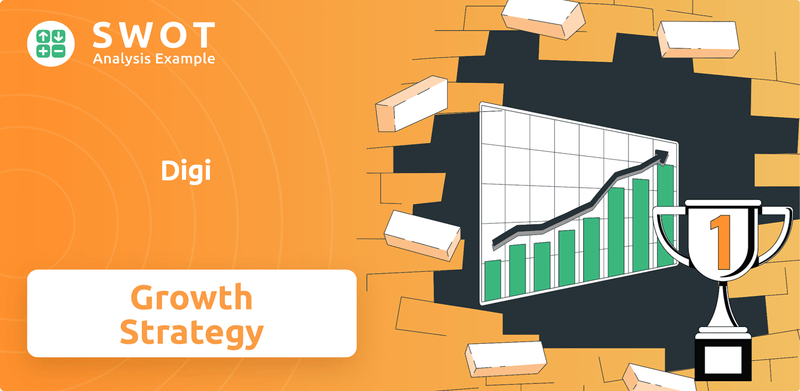
This analysis will explore Digi's Digi SWOT Analysis, examining its Digi growth strategy and future prospects within the competitive landscape. We'll delve into Digi's strategic initiatives, market expansion plans, and financial performance, considering factors like 5G adaptation and customer acquisition strategies. Understanding Digi's long-term growth potential requires a close look at its digital transformation strategy and how it navigates regulatory changes.
How Is Digi Expanding Its Reach?
Digi International is focused on expanding its business, primarily by growing its Annualized Recurring Revenue (ARR). This growth strategy involves a solution-oriented approach and strategic acquisitions. The company aims to increase its ARR and Adjusted EBITDA to $200 million within the next four years, with acquisitions potentially speeding up this timeline.
The company's capital allocation strategy prioritizes acquisitions. Digi takes a disciplined approach, focusing on opportunities that offer scale and ARR. This approach is key to its overall Digi growth strategy and future prospects.
Digi is exploring partnerships and distribution channels in regions where IoT adoption is increasing. This market expansion is a key part of their strategy. The company's IoT Solutions segment, including SmartSense and Ventus, is a significant driver of recurring revenue.
The IoT Solutions segment saw a 9% increase in ARR, reaching $95 million by the end of the second fiscal quarter of 2025. This growth was primarily driven by recurring revenue. This segment includes solutions like SmartSense and Ventus.
The IoT Product & Services segment also contributed to recurring revenue growth. This segment increased by $1.2 million in the second fiscal quarter of 2025. This indicates a strong focus on recurring revenue streams.
Digi continues to invest in its customer-facing roles to support its expansion efforts. An additional $5 million in operating expenses has been allocated for this purpose. This investment is crucial for customer acquisition strategies.
Acquisitions are a key part of Digi's capital allocation strategy. The company focuses on acquisitions that can scale and boost ARR. This disciplined approach is essential for long-term growth potential.
Digi's expansion initiatives are centered around growing ARR through a solution-oriented approach and strategic acquisitions. The company is also focused on market expansion through partnerships in regions with growing IoT adoption.
- Focus on increasing Annualized Recurring Revenue (ARR).
- Strategic acquisitions to accelerate growth.
- Investment in customer-facing roles.
- Exploring partnerships for market expansion.
Digi SWOT Analysis
- Complete SWOT Breakdown
- Fully Customizable
- Editable in Excel & Word
- Professional Formatting
- Investor-Ready Format
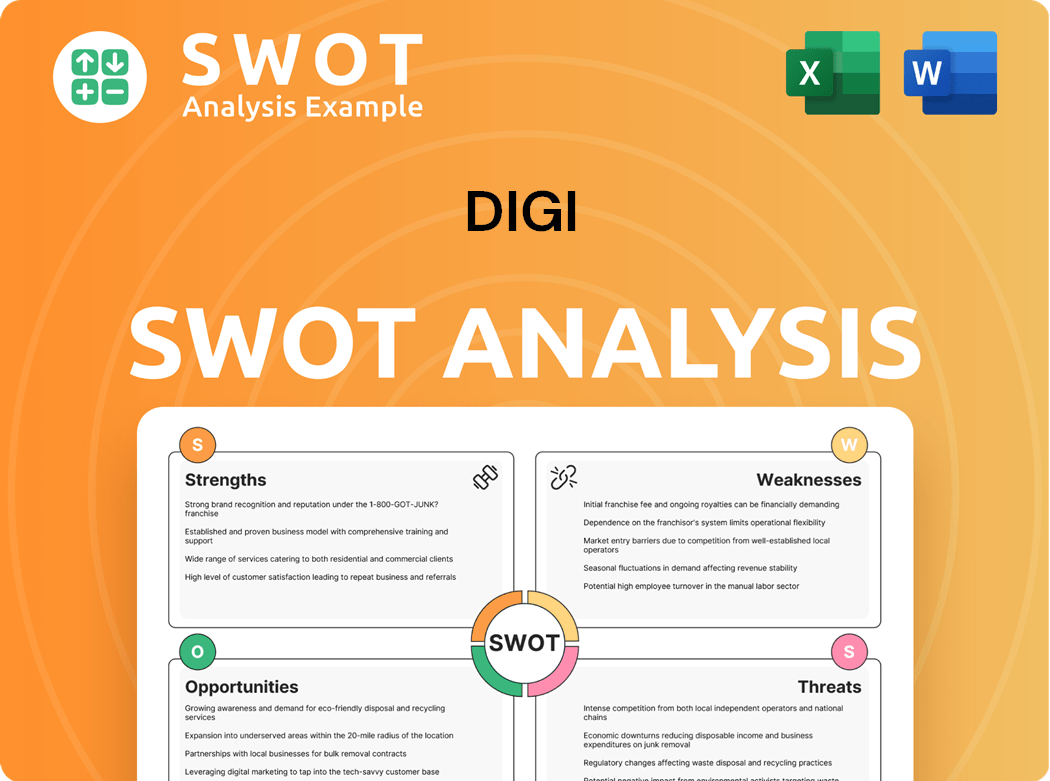
How Does Digi Invest in Innovation?
The company's growth strategy heavily relies on innovation and technology to maintain its competitive edge in the telecommunications industry. The company is focused on research and development (R&D) to bring innovative Internet of Things (IoT) connectivity products to market. This approach is crucial for adapting to the rapid pace of technological advancements and ensuring long-term growth.
A significant portion of the company's strategy involves digital transformation and the integration of artificial intelligence (AI) into its business processes and offerings. This includes enhancing software and security features, which is expected to boost its Annual Recurring Revenue (ARR). The company aims for approximately 30% of its revenue to be ARR by the end of fiscal year 2025.
The company's commitment to innovation is further demonstrated by its investment in R&D, allocating 15% of its revenue to this area. This investment underscores its dedication to staying ahead of technological advancements and developing cutting-edge products.
The company invests a significant portion of its revenue in R&D. This investment supports the development of innovative IoT connectivity products.
New product rollouts, such as the Digi IX40, are key to the company's growth strategy. These products provide advanced connectivity solutions for various industrial applications.
Digital transformation and AI integration are central to the company's strategy. This includes AI implementation for network management.
A significant percentage of senior leadership has fully implemented AI for network management. Network engineers anticipate increased investment in AI.
The company aims to increase its Annual Recurring Revenue (ARR). Software and security enhancements are expected to contribute to this goal.
The Digi IX40 is designed for Industry 4.0 applications. This includes smart manufacturing and predictive maintenance.
The company's focus on innovation extends to its product offerings, particularly in cellular solutions. The Digi IX40, launched in 2024, is an example of its commitment to providing advanced connectivity solutions. This industrial edge computing solution supports Industry 4.0 applications by offering 5G connectivity, edge intelligence, and real-time processing. The company's strategic initiatives in 2024 include focusing on expanding its market share and adapting to 5G technologies. For more detailed insights into the company's financial performance and revenue streams, you can explore the Revenue Streams & Business Model of Digi.
The company is leveraging several key technological advancements to drive its growth and maintain a competitive edge in the telecommunications industry. These advancements are integral to the company's strategic initiatives and future prospects.
- 5G Connectivity: The Digi IX40 provides 5G connectivity.
- Edge Intelligence: The Digi IX40 offers edge intelligence capabilities.
- AI Integration: The company is integrating AI into its business processes.
- Real-Time Processing: The Digi IX40 supports real-time processing for industrial applications.
Digi PESTLE Analysis
- Covers All 6 PESTLE Categories
- No Research Needed – Save Hours of Work
- Built by Experts, Trusted by Consultants
- Instant Download, Ready to Use
- 100% Editable, Fully Customizable
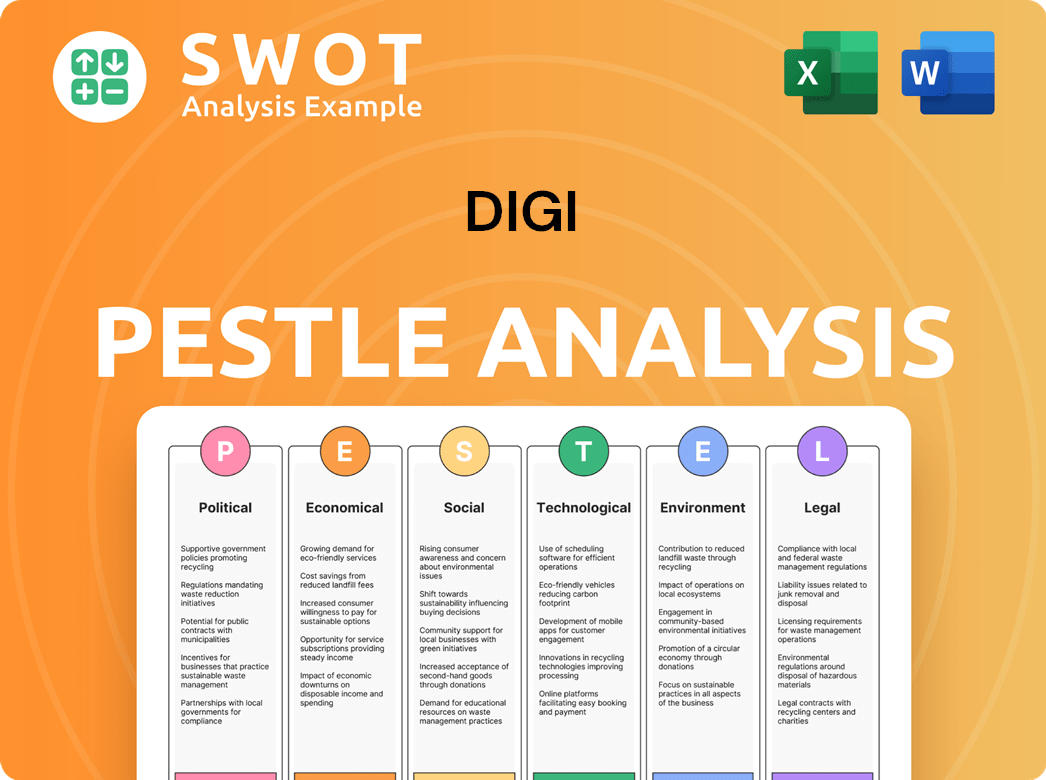
What Is Digi’s Growth Forecast?
The financial outlook for Digi International in fiscal year 2025 indicates a focus on sustainable growth. The company's Digi growth strategy includes expanding its Annualized Recurring Revenue (ARR), which is projected to increase by approximately 10%.
While overall revenue is expected to remain flat year-over-year, Digi is concentrating on improving profitability and operational efficiency. The company's Digi future prospects appear promising, with strategic initiatives aimed at enhancing its market position within the telecommunications industry.
Digi's recent financial performance showcases its ability to navigate market challenges. For the first fiscal quarter of 2025, ending December 31, 2024, revenue was $104 million, a 2% decrease year-over-year. However, the gross profit margin improved to 62.0%, and net income reached $10 million, a significant increase from a net loss of $3 million in the previous year.
Revenue of $104 million, a 2% decrease year-over-year.
Gross profit margin increased to 62.0%.
Reached $10 million, compared to a net loss of $3 million in the prior year.
Adjusted net income per diluted share for Q1 2025 was $0.50, up from $0.48.
The second fiscal quarter of 2025, which concluded on March 31, 2025, showed a revenue of $105 million, a 3% decrease year-over-year. Despite this, the company exceeded earnings expectations, with an Earnings Per Share (EPS) of $0.51, surpassing the forecasted $0.48. Annual recurring revenue (ARR) grew by 12% year-over-year to $123 million. Digi also demonstrated strong cash flow from operations, generating $26 million in Q2 2025, and reduced its net debt to $45 million, with plans to be net cash positive by the end of the fiscal year. The company's full-year 2025 profit outlook has been increased, and Adjusted EBITDA is now projected to grow 5% year-over-year. Analysts expect Digi International's earnings to grow 7.74% next year, from $1.68 to $1.81 per share. For more insights, check out the Target Market of Digi.
Revenue decreased by 2% year-over-year in Q1 2025 and 3% in Q2 2025.
Gross profit margin improved to 62.0% in Q1 2025.
Annual Recurring Revenue (ARR) grew by 12% year-over-year to $123 million.
Generated $26 million in cash flow from operations in Q2 2025.
Reduced net debt to $45 million, aiming to be net cash positive by the end of the fiscal year.
Adjusted EBITDA is projected to grow 5% year-over-year.
Digi Business Model Canvas
- Complete 9-Block Business Model Canvas
- Effortlessly Communicate Your Business Strategy
- Investor-Ready BMC Format
- 100% Editable and Customizable
- Clear and Structured Layout
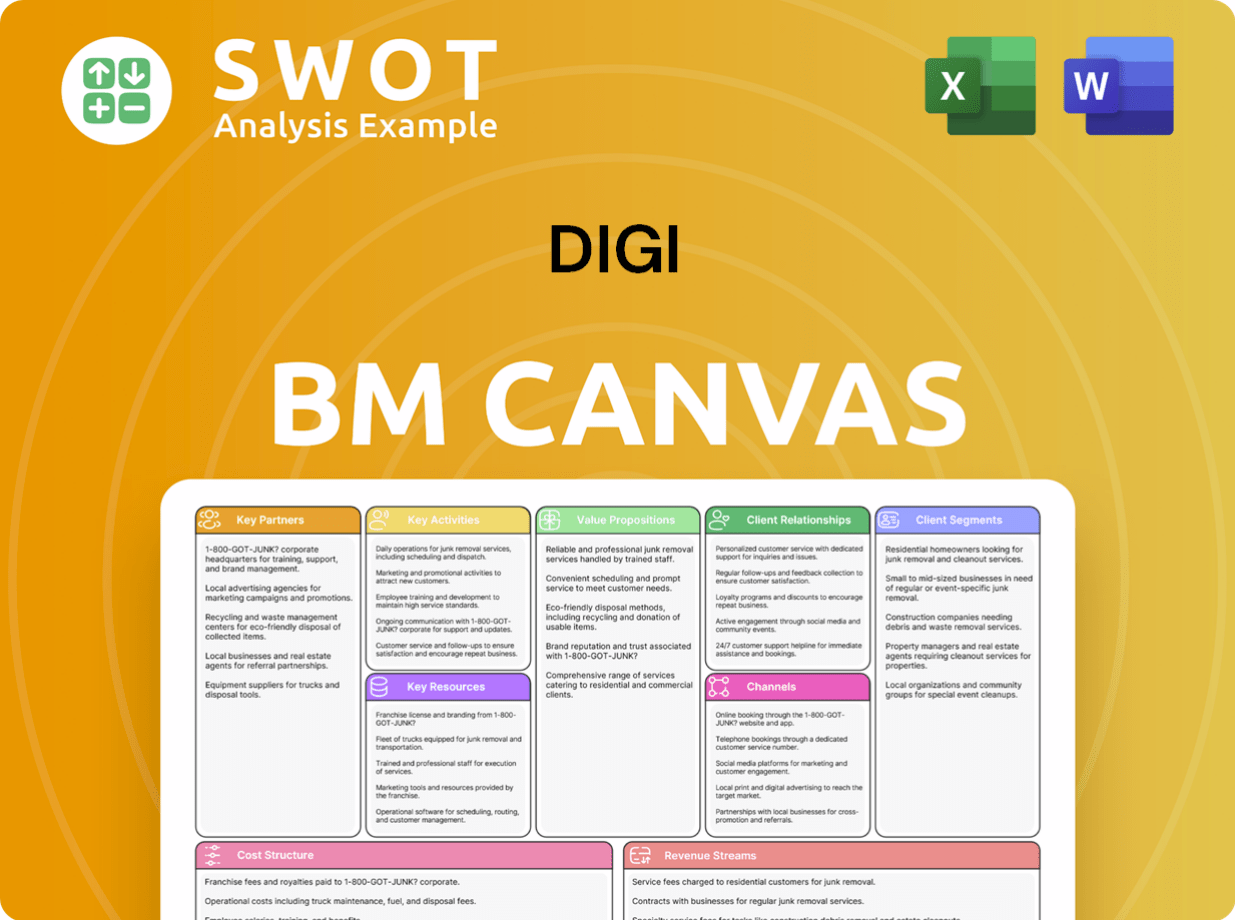
What Risks Could Slow Digi’s Growth?
The company faces several potential risks and obstacles that could impact its growth. These challenges range from market competition to technological disruptions, all of which could affect its strategic initiatives and financial performance. Understanding these risks is crucial for evaluating the company's long-term growth potential and making informed decisions.
Market competition poses a continuous challenge in the rapidly evolving IoT industry. The company also navigates potential regulatory changes, including the expansion of tariffs, which can introduce uncertainty regarding economic policies and taxation. Supply chain challenges continue to impact businesses globally, potentially affecting product demand and the financial solvency of customers and suppliers.
Technological disruption is another significant risk, as rapid changes in technologies could displace existing products. Specifically, the integration of artificial intelligence presents challenges related to complex regulatory and legal frameworks, as well as the need to ensure ethical AI use. Failure to manage these AI-related risks could lead to regulatory penalties, reputational damage, or a competitive disadvantage if competitors are more adept at leveraging AI.
The telecommunications industry is highly competitive, with numerous players vying for market share. This competition can put pressure on pricing and profitability. The company must continually innovate and adapt to maintain its competitive edge in the market.
Changes in regulations, including those related to tariffs and taxation, can create uncertainty. These changes can impact the company's operational costs and strategic planning. The company needs to monitor and adapt to these changes to mitigate their effects.
Disruptions in the supply chain can affect the availability of components and products. These disruptions can lead to delays and increased costs. The company must manage its supply chain effectively to minimize these risks.
Rapid technological advancements can make existing products obsolete. The company needs to invest in research and development to stay ahead of the curve. Adapting to new technologies is crucial for long-term success.
The integration of artificial intelligence brings complex regulatory and ethical challenges. These risks include potential penalties and reputational damage. The company must manage these AI-related risks carefully.
Macroeconomic factors, especially in industrial markets and the APAC region, can pose challenges. These factors can affect the demand for products and services. The company must adapt to these economic conditions.
The company focuses on recurring revenue models to stabilize its income. It also pursues solution-oriented acquisitions to expand its offerings. Disciplined capital allocation is used to ensure efficient resource management. These strategies are designed to address the risks and support the company's financial performance.
The company's strong cash generation helps it manage financial risks. Efforts to manage inventory levels also contribute to its financial stability. These financial practices are key to navigating the challenges and ensuring long-term sustainability. For more details, you can read about the Brief History of Digi.
Digi Porter's Five Forces Analysis
- Covers All 5 Competitive Forces in Detail
- Structured for Consultants, Students, and Founders
- 100% Editable in Microsoft Word & Excel
- Instant Digital Download – Use Immediately
- Compatible with Mac & PC – Fully Unlocked
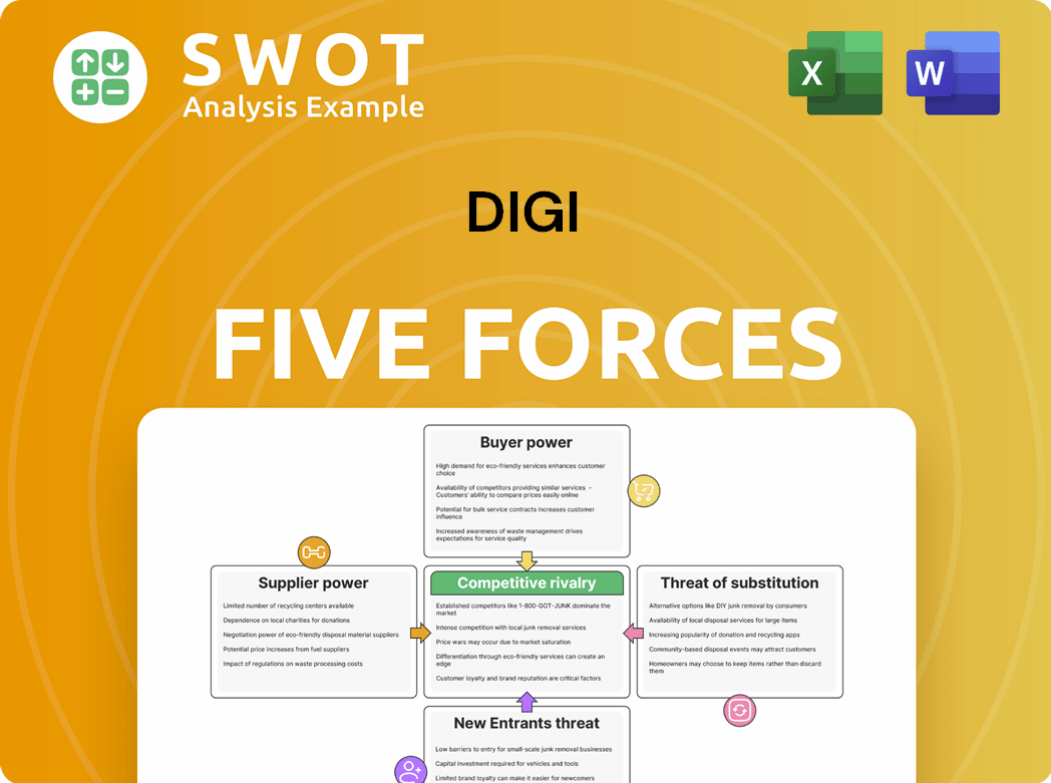
Related Blogs
- What are Mission Vision & Core Values of Digi Company?
- What is Competitive Landscape of Digi Company?
- How Does Digi Company Work?
- What is Sales and Marketing Strategy of Digi Company?
- What is Brief History of Digi Company?
- Who Owns Digi Company?
- What is Customer Demographics and Target Market of Digi Company?
Disclaimer
All information, articles, and product details provided on this website are for general informational and educational purposes only. We do not claim any ownership over, nor do we intend to infringe upon, any trademarks, copyrights, logos, brand names, or other intellectual property mentioned or depicted on this site. Such intellectual property remains the property of its respective owners, and any references here are made solely for identification or informational purposes, without implying any affiliation, endorsement, or partnership.
We make no representations or warranties, express or implied, regarding the accuracy, completeness, or suitability of any content or products presented. Nothing on this website should be construed as legal, tax, investment, financial, medical, or other professional advice. In addition, no part of this site—including articles or product references—constitutes a solicitation, recommendation, endorsement, advertisement, or offer to buy or sell any securities, franchises, or other financial instruments, particularly in jurisdictions where such activity would be unlawful.
All content is of a general nature and may not address the specific circumstances of any individual or entity. It is not a substitute for professional advice or services. Any actions you take based on the information provided here are strictly at your own risk. You accept full responsibility for any decisions or outcomes arising from your use of this website and agree to release us from any liability in connection with your use of, or reliance upon, the content or products found herein.